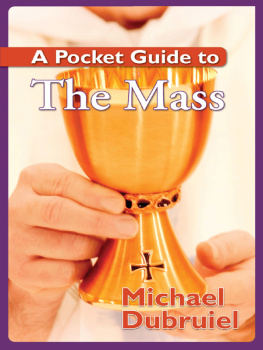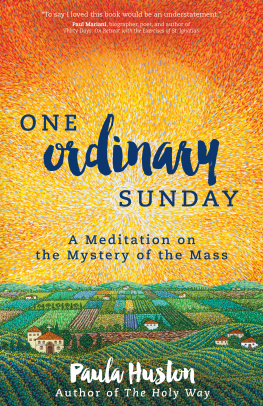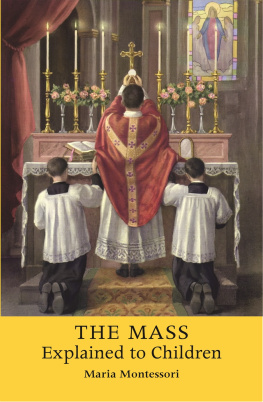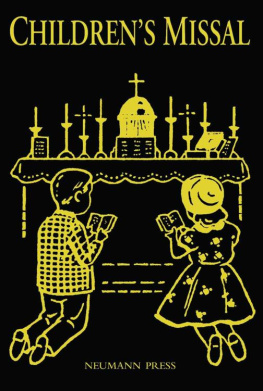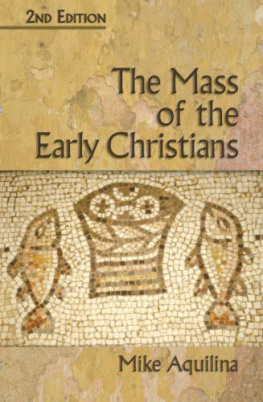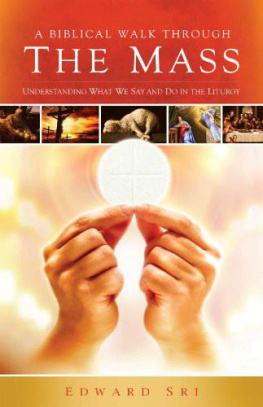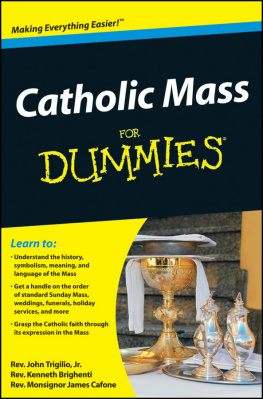Chapter I
PREPARATION FOR MASS
When someone firstapproaches a Catholic church, he should have some sense of the presence of thesupernatural in the world. In Catholic lands, the church is often placed in thecenter of the town, perhaps on the main square, and its position serves toremind us that the Church is fully in the world, incarnate because her Masterbecame incarnate, placed at the center of daily life. If a town is laid outwith a cathedral or church at the heart, it reminds us that everything elseexists in relationship to God, and ought to be lived or done for him.
Ifthe position of the building reminds us that the Church is in the world,however, its architecture has been calculated to show us that the Church is notof the world. Whether viewing the Gothic spires of a medieval church or theample carved facade of a baroque one or even the variety of geometrical formsthat characterize some modern church architecture, one finds oneself before abuilding whose structure proclaims that it is not a utilitarian enclosure, butone set aside for sacred usethe house of God and gate of heaven. The artistryof the building should serve as a reminder that to step through the doors isnot simply to move a few feet in space, but to perform a religious actto makea declaration of one's belief in God and one's intention to worship him. Evenif the architecture of the church may be in some way deficient, surely aperson's faith and heart will be touched as he steps through the portal thatmarks him and sets him aside as a Christian. Surely he will be conscious thathe is passingin a sensefrom this world into the presence of God.
Once inside the church,our Christian finds himself in the presence of his Lord, who dwells in thetabernacle of this church just as he dwells in each church throughout theworld. The light of a single candle, tiny but clear, within a red glass globe,serves as a sign that the Lord of Heaven is here. It is perhaps this divinePresence dwelling in the tabernacle that gives this church a different feelfrom other spaces where people gather. Blessed John Henry Newman may be hintingat an aspect of his own conversion when he describes a young Protestantencountering the Blessed Sacrament in a Catholic church for the first time:
Whilehe was thus thinking, achange came over the worship. A priest, or at least an assistant, had mountedfor a moment above the altar, and removed a chalice or vessel which stoodthere; he could not see distinctly. A cloud of incense was rising on high; thepeople suddenly all bowed low; what could it mean? The truth flashed on him,fearfully yet sweetly; it was the Blessed Sacramentit was the Lord Incarnate who was on the altar, who had come tovisit and to bless His people. It was the Great Presence which makes a CatholicChurch different from every other place in the world; which makes it, as noother place can be, holy.
Thissame power stirs the heart of our own visitor, but in a way that is sweeter andmore familiar. Sharing in the awe of the divine Presence, he also finds himselfin a particular way united with the other people who have already arrived topray and to worship God. He might be reminded by analogy of his hoped-forentrance into eternal life, the joyous reception into the company of the blessedwho are gathered in adoration of the eternal Lamb. In any case, he shows hisreverence and love by genuflecting before his Lord, lowering himself in agesture of humility before his Maker, acknowledging that God is God and that heis God's creature, who has nothing but what God has given him.
Dippinghis hand into the holy water font, he is reminded of the waters of baptism,through which he first entered the Churchthe mystical body of Christandthrough which he was given the right by God to be here, as a member of thefamily of the saints. Making the sign of the cross, he traces over his body thesign of his redemption, the price paid by Christ to bring him here and unitehim with himself. The recitation of the name of the Trinity is both creed andsupplication, a request for divine aid and a confession of the one whosecompany he now shares; an acknowledgment of whose divine life the Christian nowenjoys. The believer then moves down the aisle, drawing closer to the altarwhere the divine mysteries will be made present, and to the tabernacle wherethe divine Presence now dwells. Having come close enough, he again genuflectsbefore the mystery of God's presence, and takes his place in the pew. Becausethe pew has no armrests, he is not divided from his neighbor, and there isalways space to welcome one more soul.
Awareof what is about to take place, let our Christian prepare himself well for whatis to come! Let him take the time before Mass to kneel before his God, askingto be made worthy to receive his creator. Perhaps he will recite the prayer ofSt. Thomas, "Almighty and ever living God, I approach the sacrament ofyour only-begotten Son ..." Perhaps he has made a point to come early sothat he might confess his sins to the priest before he receives the Holy Onehimself from the priest's hands. In any case, let him put these preciousminutes to good use, for what he is about to do is more important than anythingelse he has done in his lifehe is about to dare to receive his God into hisown body.
Chapter II
THE OPENING RITES
In the name of the Father, and of the Son, and of the Holy Spirit.
Amen.
The Lord be with you.
And with your spirit.
Brethren, let us acknowledge oursins, that we may prepare ourselves to celebrate the sacred mysteries.
I confess to almighty God
and to you, my brothers and sisters,
that I have greatly sinned
in my thoughts and in my words,
in what I have done and in what I
have failed to do,
And, strikingtheir breast, they say:
through my fault, through my fault,
through mymost grievous fault;
Then theycontinue:
therefore I ask blessed Mary ever-Virgin, all the Angels andsaints, and you, my brothers and sisters, to pray for me to the Lord our God.
May almighty God have mercy on us and lead us, with our sinsforgiven, to eternal life. Amen.
Lord have mercy.
Lord have mercy.
Christ have mercy.
Christ have mercy.
Lord have mercy.
Lord have mercy.
When the music of theopening antiphon first fills the church, and the whole congregation rises inunison, one cannot help but feel that something has changed. Before, as eachperson made his private preparation for the Mass, the unity of every Christianwas present in a spiritual way, through the mutual bond of common prayer. Now,however, that spiritual reality is physically expressed, as each voice takes upthe same song, and everyone faces forward, oriented toward a horizon visible tothe eyes of faith.
Asthe procession makes its way down the center aisle, the cross is held forwardfor everyone to see, rising above the heads of the crowd. The simple form oftwo crossed beams bears the carved weight of a broken yet triumphant body. Itis the standard of the Christian people. But how different it is from the proudbanners of nations! Where human societies proclaim the greatness of theirachievements, the Church proclaims the death of her head. Where states proudlydemand recognition of their might, the Church offers the icon of humility andlove, of the God-man who willingly suffered ignominious death for love of hispersecutors, of Christ who by his cross triumphed over death.
Disposedin order behind the cross are the various servers and ministers, representingthe whole Christian people, who have chosen to take up their own crosses dailyand follow the Lord. Before the cross, a minister swings the thurible full ofincense, a cloud billowing up to God like the prayers of his people. The bandsof smoke twine around the crucifix, like spiritual garlands decorating thevictor's trophy. Even where the smoke is not seen, its sweet fragrancepermeates the church, a herald of the coming of Christ, and a reminder of hissweet meekness and great dignity.
Next page

